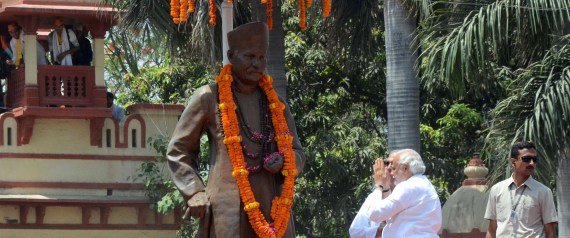 Eminent educationist and politician Pandit Madan Mohan Malaviya will be conferred India’s highest civilian award—the Bharat Ratna. Here are some highlights and achievements from his life, and why his legacy is being celebrated rather belatedly.
Eminent educationist and politician Pandit Madan Mohan Malaviya will be conferred India’s highest civilian award—the Bharat Ratna. Here are some highlights and achievements from his life, and why his legacy is being celebrated rather belatedly.
1) Born into a family of Sanskrit scholars on December 25, 1861 in Allahabad, he began his education in Sanskrit at the age of five. His ancestors hailed from Malwa, Madhya Pradesh and hence came to be known as ‘Malviyas’. His father, Pandit Baijnath, used to recite the Bhagavata Purana for a living.
2) He was the founder of one of Asia’s biggest residential universities—the Banaras Hindu University. It took nearly 10 years to get the foundation stone laid—the idea of a Hindu university was floated in the form of a prospectus in 1905. He gave up his legal practice and launched his mission in January, 1911, and made an appeal to raise 1 crore rupees for the establishment of the university to the public. By early 1915, fifty percent of the target was achieved through donations made by all sections of society—rich and poor, peasants and princes. The foundation stone was laid on 4th February, 1916 by Lord Hardinge.
3) He was one of the early leaders of the Akhil Bharatiya Hindu Mahasabha, a far-right Hindu Nationalist party, but was a passionate advocate of Hindu-Muslim unity, and by far one of the most moderate voices in the organisation. At the Congress session in Kolkata in 1913, he said: “India belongs to the Hindus, the Mohammedans, the Sikhs, the Parsis and others. No single community can run over the rest. Your hand has five fingers. If you put off the thumb, the power of your hand will be reduced to one-tenth of its original power. Act in such away that all may unite… Let there be mutual trust.”
The BJP and the RSS have its origins in the Hindu Mahasabha—the Rashtriya Swayamsevak Sangh was founded by Keshav Baliram Hedgewar in 1925, a former member. Shyama Prasad Mookerjee, founder of the Bharatiya Jana Sangh, a precursor to the BJP, was also a former member.
The Akhil Bharatiya Hindu Mahasabha recently announced their plans to build a temple for Nathuram Godse, Mahatma Gandhi’s assassin.
4) He had many titles bestowed upon him—Rabindranath Tagore gave him the title “Mahamana”, Mahatma Gandhi called him a “Pratah Smaraniyah” and “Devata Purush”. He’s also been called a ‘Dharmatma’, “Karmayogin” and “Prince of Beggars”.
5) He popularised the phrase Satyameva Jayate, from the Mundaka Upanishad, which means Truth Alone Triumphs. It was adopted as India’s national motto and appears on its emblem.
6) He was an avid journalist and writer, he launched a Hindi-language weekly, the Abhyudaya, in 1907, and an English newspaper, The Leader in 1909, as well as a Hindi monthly magazine called Maryada in 1910. He was the chairman of the board of Hindustan Times from 1924 to 1946, and facilitated the launch of its Hindi edition in 1936.
7) He served as Congress President four times—in 1909 (Lahore), in 1918 (Delhi), in 1930 (Delhi) and in 1932 (Calcutta). He was an important figure in the non-cooperation movement, and was opposed to Congress’ participation in the Khilafat movement. He initiated a “Buy Indian” movement in India, and was arrested in 1932 with 450 other Congress volunteers. Malayiva left the Congress to form the Congress Nationalist Party and won 12 seats in the 1934 general elections.
8) He started his career as a teacher in Allahabad District School. One of the founders of Scouting in India, he founded the Seva Samiti Scout Association (Humanity Uplift Service Society) in 1917 in Allahabad.





